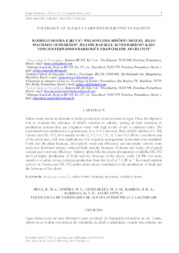Tolerance of alfafa varieties subjected to salinity.
Tolerance of alfafa varieties subjected to salinity.
Author(s): SILVA, R. M. e; SIMOES, W. L.; GUIMARÃES, M. J. M.; BARROS, J. R. A.; BARBOSA, K. V. F.; ANGELOTTI, F.
Summary: Saline water can be an alternative for the production of salt-tolerant forages. Thus, the objective was to evaluate the tolerance of alfalfa varieties to salinity, aiming at their inclusion in production systems that use irrigation water with high levels of salt or salinized soils. The experiment was conducted in a greenhouse, in a 3x5x3 factorial, three alfalfa varieties (LE-N4, Crioula and DK-192), five salinity levels (0; 3.5; 5.0; 7.0; 10. 5 and 14.0 dS m-1) and three cuts of the aerial part, with four replications. For irrigation management, lysimeters were installed. Fresh and dry plant biomass, chlorophyll, water use efficiency and enzymatic activity were analyzed. Increased salinity reduced fresh and dry biomass of shoots and roots, chlorophyll content and water use efficiency. Salinity altered the biochemical responses of alfalfa. DK-192 showed higher production of fresh and dry biomass of the shoot, while LE-N4 was more sensitive to saline stress, reducing production from the level of 7.0 dS m-1. Increased catalase activity in Crioula and DK-192 under saline stress contributed to the production of fresh and dry biomass of the shoot.
Publication year: 2023
Types of publication: Journal article
Unit: Embrapa Semi-arid Region
Observation
Some of Embrapa's publications are published as ePub files. To read them, use or download one of the following free software options to your computer or mobile device. Android: Google Play Books; IOS: iBooks; Windows and Linux: Calibre.
Access other publications
Access the Agricultural Research Database (BDPA) to consult Embrapa's full library collection and records.
Visit Embrapa Bookstore to purchase books and other publications sold by Embrapa.

